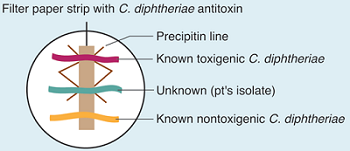Elek's plate test - Principle, Purpose, Procedure, Result, Interpretation, History
Introduction to Elek's plate test
Elek's test (also known as Elek plate test or Elek gel precipitation test) is an in vitro test to test the virulence of Corynebacterium diphtheriae, the causative agent of the infection diphtheria.
Acute airborne pulmonary disease was a major health concern as it killed entire families from the late 1800s to the early 1900s. Fortunately, after the diphtheria vaccine was made, the disease was bought under control.
History of Elek's plate test
Elek's test was invented by Hungarian-born British microbiologist Stephen Dyonis Elek in 1949. During this time, diphtheria was not entirely controlled and this method bought great advantages to previous tests in diagnosis.
Elek's plate test was rapid and allowed in vitro tests, completely replacing the need for clinical tests on laboratory animals.
Purpose of Elek's plate test
Elek's plate test's main purpose is to check for the toxigenicity of C. diphtheriae strains.
Principle of Elek's plate test
Elek's plate test method is based on the principle of immunodiffusion (immunoprecipitation). Once placed on the culture media, the antitoxin previously absorbed by the filter paper while the toxin produced by toxin-producing strains diffuses away from growth.
At a certain point, an equivalence is reached, forming a line of precipitin where antibodies from the serum and antigens from the toxin bind.

Fig: Elek's test (Source: Pinterest)
Procedure of Elek's plate test
The procedure of Elek's plate test is as follows:
Bury Whatman filter paper impregnated with 50 units/ml of diphtheria antitoxin in the center, beneath the surface of serum culture medium, just before agar solidifies.
Streak test organism(s), known negative toxigenic strain (control 1), and known positive toxigenic strain (control 2) in a line across the plate and perpendicular to the buried antitoxin paper strip.
Incubate at 35-37°C for 18-24 hours.
Observe for line(s) of precipitin at 45° between the strip and inoculated organisms.
* The serum culture medium is prepared by adding 3 ml of serum to 15 ml of Proteose peptone agar or Columbia agar.
Result, Interpretation of Elek's plate test
The result of Elek's plate test can be interpreted as follows:
Positive
Following incubation, line(s) of precipitin at the zone of equivalence, at 45° between the strip and inoculated organisms, can be observed. This confirms that the test microorganism is C. diphtheriae.
Negative
No line of precipitin at the zone of equivalence can be observed near the test strain indicating the test organism is not C. diphtheriae.
* The line of precipitin is present/absent depending upon the type of control strain used. If a known negative toxigenic strain is used, there is no precipitin and if a positive toxigenic strain is used, a precipitin line must be present.
In cases of lack of positive control, just the use of negative control can aid the definitive identification of the pathogen.